People
Conceptual Photographer Thomas Demand on Why He Decided to Anonymously Design a Store Window for Every Prada Boutique in the World
The project is Demand's first-ever collaboration with a fashion brand.
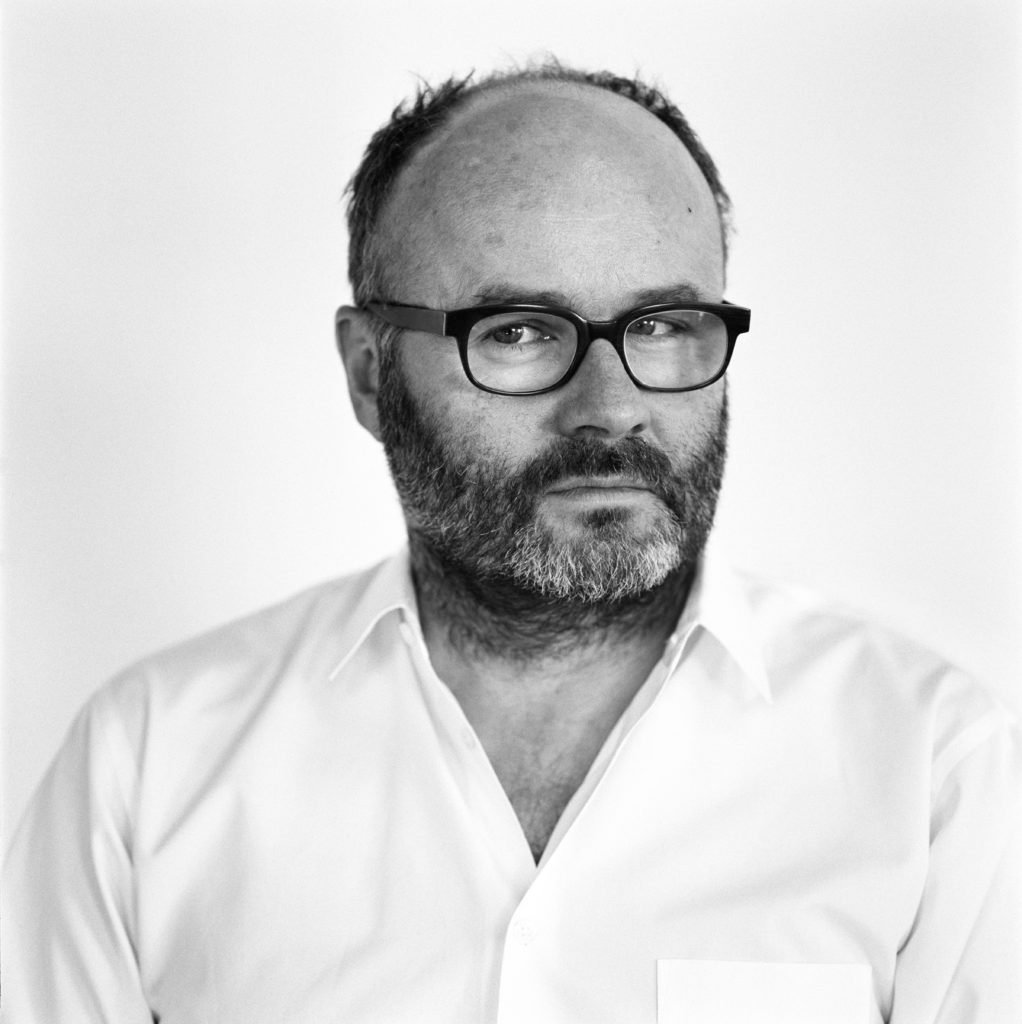
The project is Demand's first-ever collaboration with a fashion brand.

Noor Brara

For years now, German photographer Thomas Demand has stressed the fragility of our perceptions. His pictures, which he shoots after painstakingly recreating scenes from everyday life with cardboard and paper, have always played with replication and transience, and he has always insisted on destroying his sets as soon as he’s done with them.
“The minute a work shows something, it’s over,” he tells Artnet News. “Like any other moment in life that passes you by.”
For the past ten years, he has also maintained a close relationship with Miuccia Prada and her Milan-based contemporary art museum, the Fondazione Prada. While Prada and her couture house have long supported the arts, they’ve never collaborated with an artist in any official capacity—until now.
Though viewers may not be able to visit them in person, the storefront of every Prada shop in the world is showcasing Demand’s images of cherry blossoms, which he created meticulously in his first-ever project for a fashion brand. The series, titled “Hanami,” which references the centuries-old Japanese practice of enjoying the fleetingness of flowers, celebrates the onset of spring by invoking perhaps its most obvious symbol, inviting viewers to question the reality of what they see—and also of the world around them,
Demand spoke with Artnet News about working with Prada on the project and why he suspects artists and fashion brands are working more and more closely.
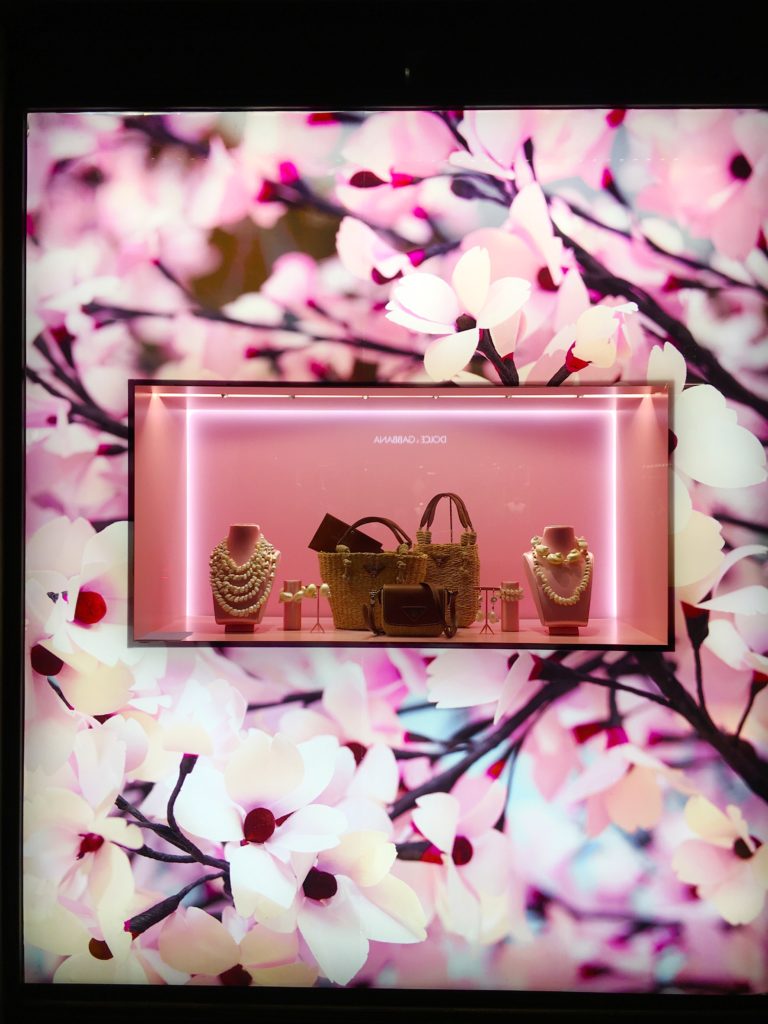
A closeup of Demand’s work at Prada Faubourg in Paris. Photo courtesy Prada.
Tell me about how Prada came to you with the opportunity to collaborate. How did it all happen?
I have a long history with the Fondazione Prada. I’ve done about 11 shows with them over the years and they have a permanent installation of mine, The Grotto. At some point, Miuccia [Prada] told me she loved the work and asked whether we shouldn’t do something together. And I thought, “What would that look like?” I trust the company and I trust that they wouldn’t exploit it if we did do something, and that they’d do it in a chic way. But also, when they proposed to me that they wanted to show [my work] in every shop window around the world at once, I thought, “That’s really quite amazing. It’s a worldwide sweep.” Of course, their audience doesn’t have a clue who I am, so the fun part for me was really about testing whether the work I do, which is quite niche within the art world, in and of itself, would work for a wider audience. It was a good way to test if the work could stand on its own—without the name, without the institution and background, all of that.
Walk me through the nuts and bolts of what the collaboration actually consisted of.
They came up with a proposal of how it would look. To my surprise, it wasn’t at all what I thought it would be—you know, a standard set of six modules that they’d use in every shop window. There’s a team in northern Italy that plans every set of windows globally and it’s a very specific, involved process.
In terms of the artwork, for a while, I was quite fascinated by the presence of a cherry blossom tree [near] my studio. I started taking photographs of it during different times of the day, as the light shifted. So I had, I don’t know, 900 photographs of different states of that tree. I never did much with them—I did a book with Ben Lerner, which featured maybe 42 of them—but other than that, all the other materials were just sitting there, sleeping, waiting to be used. And so when the Prada proposal came up, I went through the whole selection with the team, all the files, and we chose a surprisingly wide variety to use in all the different shops, keeping in mind their unique aspects. And we experimented with size—I’d never blown up things before. The petals were way bigger than even human beings, so it was kind of interesting to see how that works in the context of a street view.
Because the work looks so highly artificial and realistic in terms of color scheme, I wanted to see how people would interpret it. It’s not about cherry blossoms, really. It’s about our expectations of cherry blossoms and what they emotionally connote, and what that says about us.
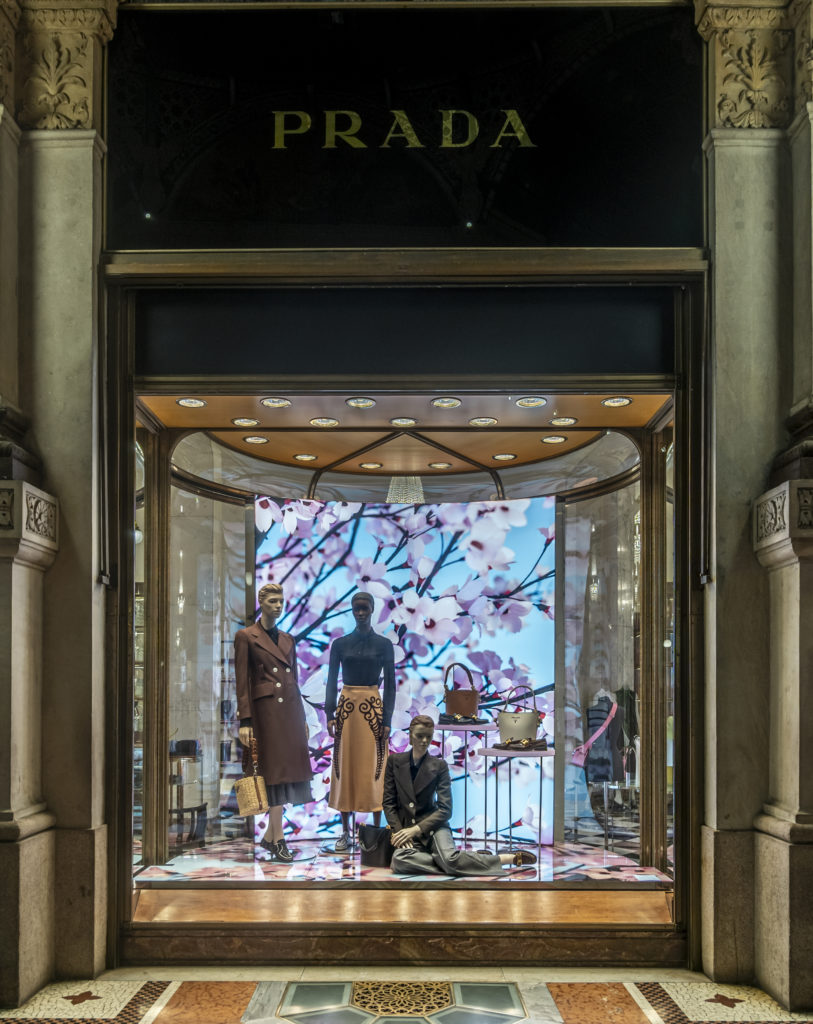
Prada at the Galleria Vittorio Emanuele in Milan. Photo courtesy Prada.
So you weren’t thinking about climate change or the fragility of nature as you were making these images?
Right. I wasn’t thinking of that specifically, but the artificiality of nature sort of implies that, doesn’t it? You build an artificial tree and the whole construction of nature is, in this case, a symbol for awakening—fresh energy, love, spring, getting back to it all after a long winter. So it’s kind of implied within that framework. The artificiality of that is, of course, that it’s art, but the pictures in the windows are more about our expectation of time and what’s coming next. The experience is the same, but it’s completely artificial.
Is there any reading material for visitors to the Prada shops to learn more about the images?
We were discussing whether my name should be on the photos, and I found it a little vulgar to do that because a shop window is a shop window, after all, and it’s supposed to showcase the goods inside the store. If you put your name on the work, that’s another message on top of the first message. So I thought it would be a little weird to put my name on it. In terms of communication about the work, Prada has communicated the background to anyone who asks and some of the shops even have the book I did with Ben Lerner. Enough people are informed, and you know, Prada’s very proud of all the artistic things they do. If you go online, you can find out about the project, it’s all there. It’s just not right in your face. I didn’t like that idea. It opened on the 10th of February, and it’s closing on the 15th of April, and then it’s going to be destroyed. I wanted it to be just like a breeze going through the shops.
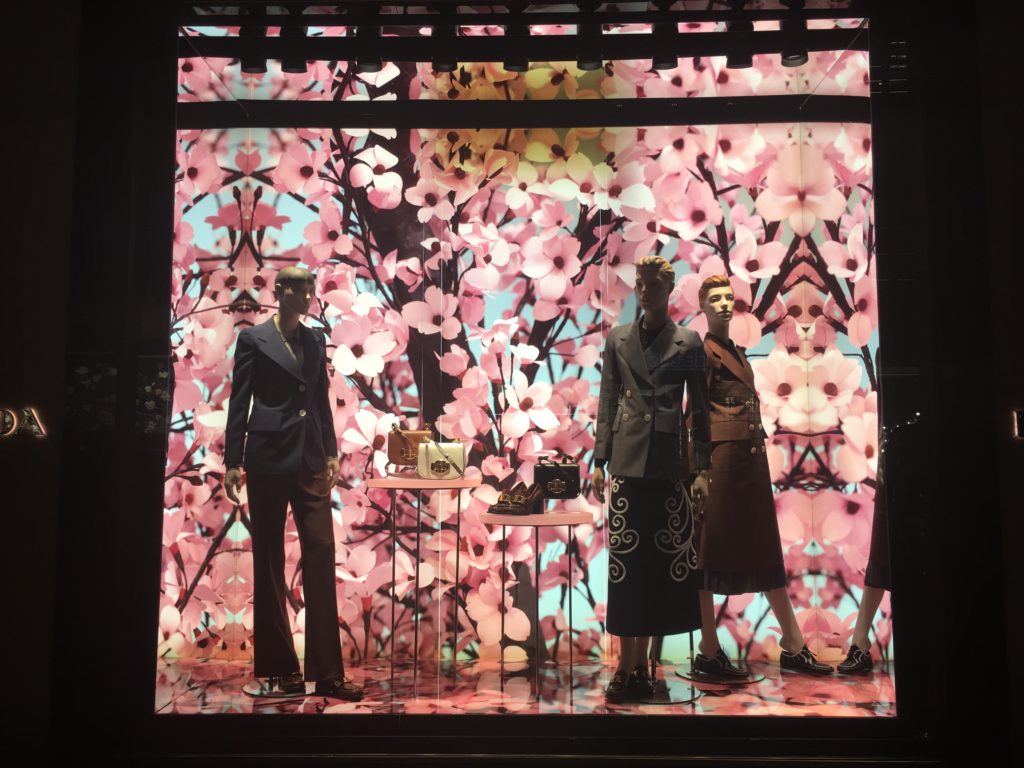
A view of Demand’s work in the window of a Prada shop on Old Bond Street in London. Photo courtesy Prada.
What drew you to doing this project in the first place? Was it because of your history with Prada, because they’ve earned your trust over the years?
Yeah. In the beginning, when I started out with them, around 15 years ago, I was like, “Okay, now I have to wear their clothes whenever I need to do something at the Fondazione.” And, to my surprise, there was never anything like that. At some point, I spoke to Miuccia about it, and she was like, “You know, that’s actually not what we want.” As far as I know, this is the first time Prada is doing something like this. They’ve never done another artist project before because they didn’t want to mix the two worlds—they didn’t want to instrumentalize one with the other. I’m kind of one of the few people who have developed quite a few projects with them, so it doesn’t really look like exploitation if I do something with them in the official collaborative sense. But I really like that they’re making an effort to make the two things truly distinct from each other.
Do you think this will be your last fashion collaboration?
I mean, who knows? The thing is, it’s about respect. Fashion is a huge machine, and usually the problem is that you’re so inexperienced in what they know so well that they can really throw you under the bus. There’s no chance of keeping up with that machine. And with Prada, I knew that I could talk to them and say, “I really need this and that” because I knew they were going to respect me. I knew that this was going to be a pleasant collaboration, but my hesitation with other companies—and I had many offers over the years—was that I just really don’t have any control over the execution of the project, and that’s probably what’s held me back. I think the world has also changed. Ten or 15 years ago, it would have been frivolous to do anything collaborative in this sense, and I think now the lines of communication—the awareness, the economy of images, everything—has changed. I think it’s completely okay to do it now.
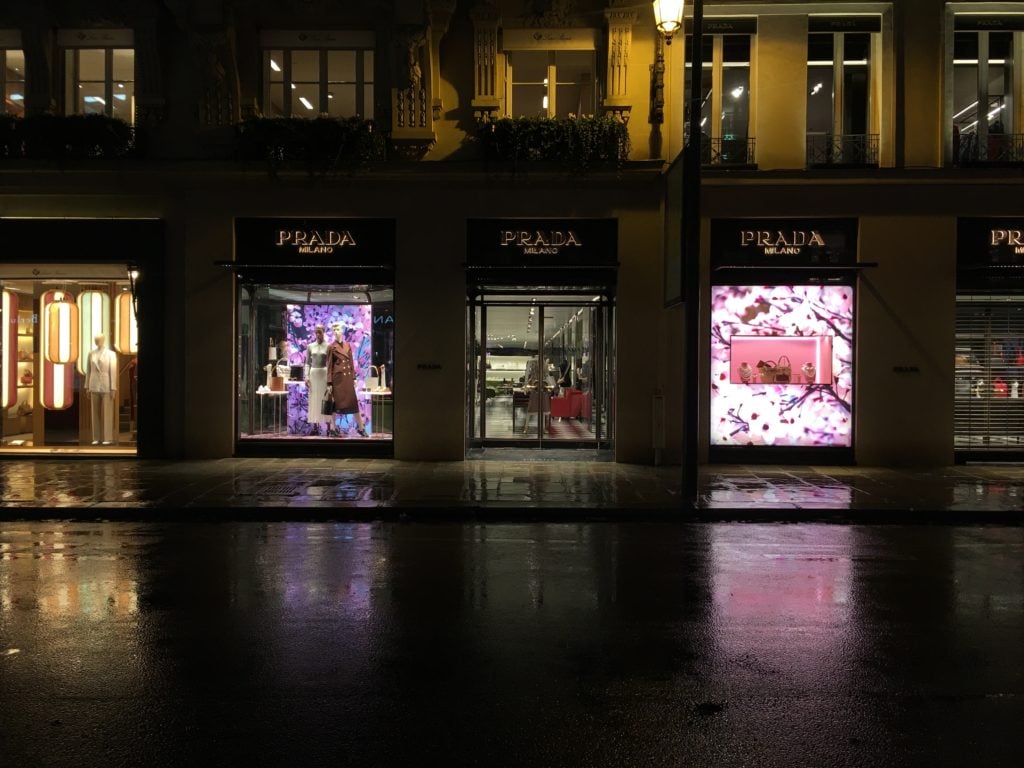
A street view of Prada Faubourg in Paris. Photo courtesy Prada.
Why do you think that’s happening more these days, that fashion brands are reaching out to artists? Why do you think artists are more willing to work with them?
That’s a hard one [laughs]. I think the obvious answer would be because they’re both luxury goods. But I don’t think that’s it, really. I don’t think art is a luxury good. If you want to own it, it is, but if you want to look at it, there are many ways to look at it. With art, the experience still very much exists in the public, so I don’t think it’s about luxury necessarily. The fashion industry is very open to all kinds of influences from normal life, which is not interesting. Think of Balenciaga or Helmut Lang, who were inspired by the mundane or the everyday. Lang started the concept of the artist as a fashion idol. I think artists have become more receptive to that and they’re not so afraid anymore of being incorporated.
It’s a different thing if you make something in collaboration, or if you actually make an object. What Sterling Ruby does is make objects—that’s a very different thing than a collaboration. And I think many of the newer fashion designers—like Rick Owens or Virgil Abloh—are working like artists. It’s one person in charge, and everyone kind of associates the design with that one person. There are lots of parallels.
What about in a runway show, where art is forced to take a backseat to fashion? Doing a show like that really can’t be primarily about commercial value, for the artist at least, because it’s just so short lived.
That’s another format that is very tricky and very difficult. Because, you’re right, it’s only for 12 minutes. You sit there, and it has to work, but it shouldn’t take the attention away from the effort of the designer. If you’re honest, there’s not much return on something like that. The pictures will be about the collection, the fashion line, and not about the goods on the floor or the staging. But nevertheless, it’s kind of fantastic—like an opera design or something. For those 12 minutes, that’s what all the effort is for. And that’s really quite amazing, that the artist and the companies would be willing to do that. The best one I saw, in that discipline, was Martin Boyce for Sonia Rykiel. It struck the right balance between the fashion and the setting. And the way the event was staged was very good for the work.

The Prada shop on Avenue Montaigne Paris. Photo courtesy Prada.
So what’s next for you?
I’m dipping into the world of architecture now, actually. I’m doing all the covers for Domos magazine. The April issue is great—they gave me complete freedom for the work, and the cover is completely separate from the content. I don’t have to illustrate anything from the magazine. To be able to do that for a whole year is actually really quite fantastic.
Then I’m building a building in Ebeltoft, a remote part of Denmark. I’ve been asked to design some kind of meeting place, with a scheme of three pavilions. It’s three buildings which are quite funky. They’re meant to open in September or October. So, I’m busy. [laughs]
Also, I did a calendar, which I’m very proud of. It’s called The Daily Flower Report, and it’s a picture of a flower for every day. It’s such a beautiful object. I did it with Irma Boom, and I look at it everyday. If you get a hold of it, it’s actually a really beautiful object. Living in LA, there’s all this sunshine and to compensate for going to buy your $5 coffee every day, I took a photo of a blossoming flower, because something is blooming every day. So I have a whole archive of 900 pictures and we made a big book of 150 pictures. And the idea of a photo calendar is so trite. But it’s lovely.